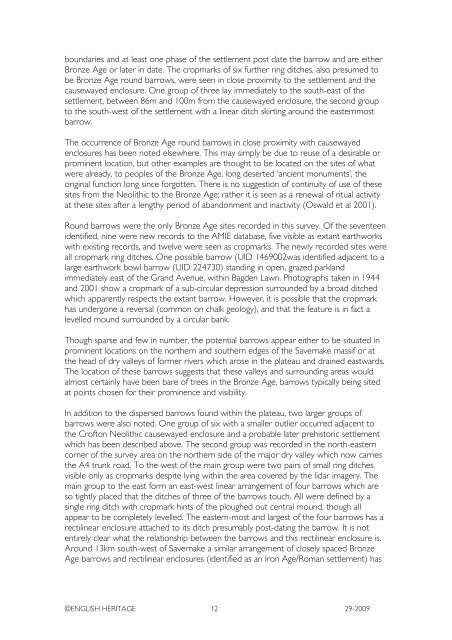savernake forest a report for the national mapping ... - English Heritage
savernake forest a report for the national mapping ... - English Heritage
savernake forest a report for the national mapping ... - English Heritage
You also want an ePaper? Increase the reach of your titles
YUMPU automatically turns print PDFs into web optimized ePapers that Google loves.
oundaries and at least one phase of <strong>the</strong> settlement post date <strong>the</strong> barrow and are ei<strong>the</strong>r<br />
Bronze Age or later in date. The cropmarks of six fur<strong>the</strong>r ring ditches, also presumed to<br />
be Bronze Age round barrows, were seen in close proximity to <strong>the</strong> settlement and <strong>the</strong><br />
causewayed enclosure. One group of three lay immediately to <strong>the</strong> south-east of <strong>the</strong><br />
settlement, between 86m and 100m from <strong>the</strong> causewayed enclosure, <strong>the</strong> second group<br />
to <strong>the</strong> south-west of <strong>the</strong> settlement with a linear ditch skirting around <strong>the</strong> easternmost<br />
barrow.<br />
The occurrence of Bronze Age round barrows in close proximity with causewayed<br />
enclosures has been noted elsewhere. This may simply be due to reuse of a desirable or<br />
prominent location, but o<strong>the</strong>r examples are thought to be located on <strong>the</strong> sites of what<br />
were already, to peoples of <strong>the</strong> Bronze Age, long deserted ‘ancient monuments’, <strong>the</strong><br />
original function long since <strong>for</strong>gotten. There is no suggestion of continuity of use of <strong>the</strong>se<br />
sites from <strong>the</strong> Neolithic to <strong>the</strong> Bronze Age; ra<strong>the</strong>r it is seen as a renewal of ritual activity<br />
at <strong>the</strong>se sites after a lengthy period of abandonment and inactivity (Oswald et al 2001).<br />
Round barrows were <strong>the</strong> only Bronze Age sites recorded in this survey. Of <strong>the</strong> seventeen<br />
identified, nine were new records to <strong>the</strong> AMIE database, five visible as extant earthworks<br />
with existing records, and twelve were seen as cropmarks. The newly recorded sites were<br />
all cropmark ring ditches. One possible barrow (UID 1469002was identified adjacent to a<br />
large earthwork bowl barrow (UID 224730) standing in open, grazed parkland<br />
immediately east of <strong>the</strong> Grand Avenue, within Bagden Lawn. Photographs taken in 1944<br />
and 2001 show a cropmark of a sub-circular depression surrounded by a broad ditched<br />
which apparently respects <strong>the</strong> extant barrow. However, it is possible that <strong>the</strong> cropmark<br />
has undergone a reversal (common on chalk geology), and that <strong>the</strong> feature is in fact a<br />
levelled mound surrounded by a circular bank.<br />
Though sparse and few in number, <strong>the</strong> potential barrows appear ei<strong>the</strong>r to be situated in<br />
prominent locations on <strong>the</strong> nor<strong>the</strong>rn and sou<strong>the</strong>rn edges of <strong>the</strong> Savernake massif or at<br />
<strong>the</strong> head of dry valleys of <strong>for</strong>mer rivers which arose in <strong>the</strong> plateau and drained eastwards.<br />
The location of <strong>the</strong>se barrows suggests that <strong>the</strong>se valleys and surrounding areas would<br />
almost certainly have been bare of trees in <strong>the</strong> Bronze Age, barrows typically being sited<br />
at points chosen <strong>for</strong> <strong>the</strong>ir prominence and visibility.<br />
In addition to <strong>the</strong> dispersed barrows found within <strong>the</strong> plateau, two larger groups of<br />
barrows were also noted. One group of six with a smaller outlier occurred adjacent to<br />
<strong>the</strong> Crofton Neolithic causewayed enclosure and a probable later prehistoric settlement<br />
which has been described above. The second group was recorded in <strong>the</strong> north-eastern<br />
corner of <strong>the</strong> survey area on <strong>the</strong> nor<strong>the</strong>rn side of <strong>the</strong> major dry valley which now carries<br />
<strong>the</strong> A4 trunk road. To <strong>the</strong> west of <strong>the</strong> main group were two pairs of small ring ditches<br />
visible only as cropmarks despite lying within <strong>the</strong> area covered by <strong>the</strong> lidar imagery. The<br />
main group to <strong>the</strong> east <strong>for</strong>m an east-west linear arrangement of four barrows which are<br />
so tightly placed that <strong>the</strong> ditches of three of <strong>the</strong> barrows touch. All were defined by a<br />
single ring ditch with cropmark hints of <strong>the</strong> ploughed out central mound, though all<br />
appear to be completely levelled. The eastern-most and largest of <strong>the</strong> four barrows has a<br />
rectilinear enclosure attached to its ditch presumably post-dating <strong>the</strong> barrow. It is not<br />
entirely clear what <strong>the</strong> relationship between <strong>the</strong> barrows and this rectilinear enclosure is.<br />
Around 13km south-west of Savernake a similar arrangement of closely spaced Bronze<br />
Age barrows and rectilinear enclosures (identified as an Iron Age/Roman settlement) has<br />
©ENGLISH HERITAGE 12 29-2009

















